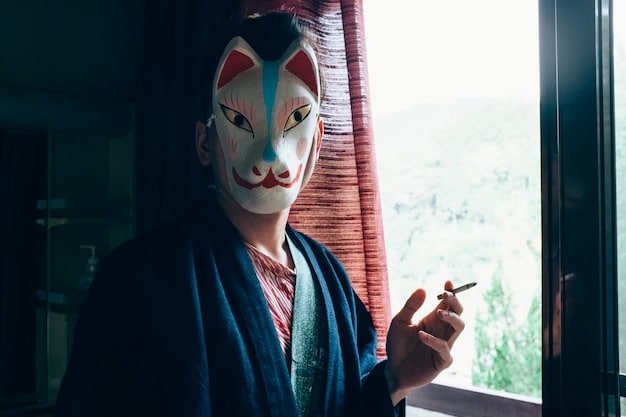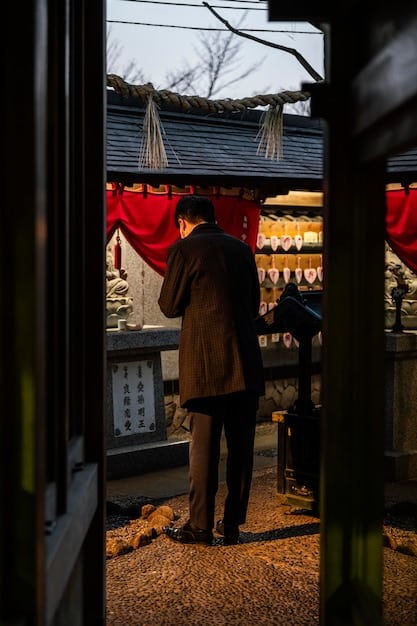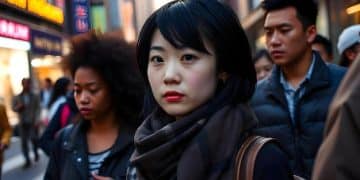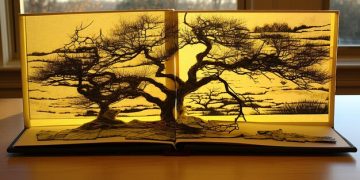Unveiling Japanese Folklore: A Supernatural J-Drama Guide

Exploring the Supernatural: A Guide to Japanese Folklore and Mythology in J-Dramas reveals how Japanese dramas (“J-Dramas”) weave traditional myths, spirits, and supernatural elements into captivating storytelling, offering viewers a unique cultural experience steeped in rich folklore.
Dive into the enchanting world where Japanese dramas meet the supernatural. Exploring the Supernatural: A Guide to Japanese Folklore and Mythology in J-Dramas unveils how these captivating series bring to life ancient myths, spirits, and otherworldly beings, offering a unique glimpse into Japan’s rich cultural heritage.
The Allure of Supernatural Themes in J-Dramas
J-Dramas have captivated audiences worldwide with their unique storytelling style and diverse themes. Among these, the supernatural stands out, blending traditional Japanese folklore with modern narratives. This fusion offers viewers an intriguing mix of suspense, drama, and cultural insight.
Why are supernatural themes so popular in J-Dramas? The answer lies in Japan’s rich mythological heritage, which provides a fertile ground for storytelling. From ancient spirits to powerful deities, Japanese folklore is filled with fascinating characters and tales that resonate with audiences of all ages.
The Roots of Supernatural Narratives
The fascination with the supernatural in Japan is deeply rooted in Shinto and Buddhist beliefs. These religions emphasize the presence of spirits (kami) in all things, blurring the line between the natural and supernatural worlds.
Modern Interpretations of Ancient Tales
J-Dramas creatively adapt these ancient tales, presenting them in modern contexts. This allows writers to explore contemporary issues while staying true to the spirit of the original stories. The result is a compelling blend of the old and the new, making these dramas both entertaining and thought-provoking.
- Cultural Preservation: J-Dramas help preserve and promote Japanese folklore, introducing these stories to a global audience.
- Creative Freedom: The supernatural theme offers writers immense creative freedom to explore complex themes and characters.
- Audience Engagement: Supernatural elements add an extra layer of intrigue and suspense, keeping viewers hooked.
Ultimately, the allure of supernatural themes in J-Dramas stems from their ability to transport viewers to a world where anything is possible, where ancient myths come to life, and where the boundaries between reality and fantasy blur.

Iconic Yokai and Spirits in J-Drama Storytelling
A cornerstone of Japanese folklore, Yokai (supernatural monsters and spirits) frequently populate J-Dramas, adding a distinct flavor to the storytelling. These creatures, ranging from mischievous pranksters to fearsome demons, offer endless possibilities for plot development and character interactions.
Understanding Yokai in J-Dramas requires a glimpse into their origins. Rooted in ancient beliefs, Yokai represent a diverse range of supernatural entities, each with unique traits and behaviors. They often embody natural phenomena, human emotions, or societal anxieties.
Kitsune (Fox Spirits)
Kitsune, or fox spirits, are among the most popular Yokai in Japanese folklore. They are often depicted as intelligent, cunning, and capable of shape-shifting. In J-Dramas, Kitsune characters can be both benevolent and malevolent, adding complexity to the narrative.
Kappa (Water Spirits)
Kappa are mischievous water spirits known for their turtle-like appearance and fondness for cucumbers. While often portrayed as pranksters, Kappa can also be dangerous, known for dragging people into the water. J-Dramas often use Kappa to add a touch of humor and folklore to the storyline.
- Symbolism: Yokai often symbolize human emotions or societal issues, providing a deeper layer of meaning to the story.
- Cultural Significance: Their presence highlights the importance of folklore and tradition in Japanese culture.
- Narrative Impact: Yokai can drive the plot, create conflict, and offer opportunities for character growth.
The enduring appeal of Yokai in J-Dramas lies in their ability to bridge the gap between the familiar and the fantastical, reminding us of the power of ancient tales and the enduring relevance of Japanese folklore.
Deities and Divine Intervention in J-Dramas
Beyond Yokai, Japanese deities play a significant role in shaping the narratives of J-Dramas. These powerful beings, drawn from Shinto and Buddhist pantheons, often intervene in human affairs, offering guidance, protection, or even punishment.
The depiction of deities in J-Dramas offers a unique perspective on Japanese spirituality. Unlike distant, unapproachable gods, Japanese deities are often portrayed as actively involved in the lives of humans, reflecting the close relationship between the human and divine realms.
Amaterasu: The Sun Goddess
Amaterasu, the sun goddess, is one of the most important deities in Japanese mythology. Symbolizing light and life, Amaterasu is often invoked in J-Dramas to represent hope, renewal, and divine favor. Her presence can bring balance to a chaotic world.
Susanoo: The Storm God
Susanoo, the storm god, is often portrayed as a rebellious and unpredictable figure in Japanese mythology. In J-Dramas, Susanoo’s presence can signify change, upheaval, and the need for transformation. His actions often challenge societal norms and expectations.
- Moral Guidance: Deities often serve as moral compasses, guiding characters towards ethical choices.
- Dramatic Conflict: Divine intervention can create both opportunities and obstacles for the protagonists.
- Cultural Reflection: The portrayal of deities reflects Japanese values and beliefs.
By incorporating deities into their narratives, J-Dramas invite viewers to contemplate the complexities of faith, morality, and the enduring power of the divine in human affairs.

Exploring Themes of Reincarnation and the Afterlife
Reincarnation and the afterlife are recurrent themes in J-Dramas, reflecting Japan’s rich spiritual traditions. These concepts explore the cyclical nature of life, the consequences of our actions, and the possibility of redemption.
The exploration of reincarnation and the afterlife in J-Dramas offers viewers a glimpse into Japanese perspectives on mortality and the human condition. By questioning the boundaries of life and death, these dramas invite viewers to reflect on their own existence and values.
Karma and Rebirth
The concept of karma, or the law of cause and effect, is central to many J-Dramas that explore reincarnation. Characters often face the consequences of their past actions, learning valuable lessons and striving for spiritual growth in their new lives.
Spiritual Journeys
J-Dramas also depict the journey of souls through the afterlife, exploring themes of judgment, purification, and the potential for enlightenment. These stories offer a sense of hope and comfort, suggesting that death is not the end, but rather a transition to a new phase of existence.
- Moral Implications: Reincarnation and afterlife scenarios often raise ethical questions about justice, forgiveness, and redemption.
- Emotional Resonance: These themes can evoke strong emotions in viewers, prompting them to consider their own beliefs about life and death.
- Narrative Depth: Exploring reincarnation and the afterlife adds layers of complexity to the storytelling.
Through their exploration of reincarnation and the afterlife, J-Dramas encourage viewers to embrace empathy, compassion, and a deeper understanding of the human experience.
Mystical Objects and Their Significance
In the realm of supernatural J-Dramas, mystical objects often play pivotal roles, imbued with magical properties and deep symbolic meanings. These artifacts can be keys to unlocking hidden powers, catalysts for dramatic events, or representations of profound cultural values.
Mystical objects in J-Dramas transcend their physical form, becoming vessels of power and symbols of deeper cultural significance. Their presence enriches the narrative, adds layers of intrigue, and connects the storyline to Japan’s rich mythological heritage.
The Power of Amulets and Charms
Amulets and charms, often adorned with sacred symbols or inscribed with prayers, are frequently used in J-Dramas to ward off evil spirits, attract good fortune, or provide protection to the wearer. These objects reflect the enduring belief in the power of ritual and symbolism.
Swords and Sacred Weapons
Swords, particularly those with legendary origins or imbued with spiritual energy, often appear in J-Dramas as symbols of power, justice, and the ability to vanquish evil. These weapons represent the warrior spirit and the importance of defending what is right.
- Narrative Devices: Mystical objects can drive the plot, create conflicts, and offer opportunities for character development.
- Cultural Insights: These objects provide insights into Japanese beliefs, rituals, and artistic traditions.
- Symbolic Representation: They often represent abstract concepts such as courage, love, or the balance between good and evil.
By incorporating mystical objects into their narratives, J-Dramas invite viewers to explore the intersection of magic, culture, and the enduring power of belief.
Blending Tradition with Modern Storytelling
One of the most compelling aspects of supernatural J-Dramas is their ability to seamlessly blend traditional Japanese folklore with modern storytelling techniques. This fusion creates a unique viewing experience that is both entertaining and culturally enriching.
The success of J-Dramas in blending tradition with modern storytelling lies in their ability to respect the essence of Japanese folklore while adapting it to contemporary audiences. This delicate balance ensures that the stories remain relevant and engaging for viewers of all backgrounds.
Contemporary Issues Through a Supernatural Lens
J-Dramas often use supernatural themes to explore contemporary social issues, such as bullying, isolation, and the search for identity. By framing these issues within a fantastical context, the dramas can offer fresh perspectives and provoke meaningful discussions.
Character-Driven Narratives
At the heart of every successful J-Drama is a compelling cast of characters. Even in supernatural dramas, the focus remains on human relationships, personal growth, and the choices that define us. The supernatural elements serve to amplify these themes and make the stories even more impactful.
- Accessibility: Modern storytelling techniques make Japanese folklore more accessible to a global audience.
- Cultural Exchange: J-Dramas foster cultural exchange by showcasing Japanese traditions and beliefs to the world.
- Entertainment Value: The blend of tradition and modernity enhances the entertainment value of the dramas.
This unique blend allows J-Dramas to transcend cultural boundaries, resonating with audiences worldwide and solidifying their place in the global entertainment landscape.
| Key Element | Brief Description |
|---|---|
| 👻 Yokai Spirits | Supernatural creatures influencing plot and culture. |
| ⛩️ Divine Deities | Gods who intervene, guiding or creating conflicts. |
| 🔄 Reincarnation | Cycle of life, exploring karma and redemption. |
| 🔮 Mystical Objects | Objects imbued with power symbolizing culture. |
▼
Not necessarily. J-Dramas encompass a wide range of genres, and while some delve into horror or suspense, many others incorporate supernatural elements in a lighthearted or comedic way.
▼
No, basic understanding of Japanese folklore isn’t required. J-Dramas often provide enough context for viewers to follow the story. However, knowledge of Japanese culture will enhance the viewing experience.
▼
Many streaming platforms offer a variety of J-Dramas. Popular options include Netflix, Crunchyroll, and Viki. Availability may vary depending on your region.
▼
Age appropriateness varies depending on the specific drama. Some J-Dramas may contain mature themes or violence, so it’s always best to check the rating before watching.
▼
J-Dramas often have a unique storytelling style, characterized by fast-paced plots, quirky humor, and a focus on character development. They also tend to be shorter than dramas from other Asian countries.
Conclusion
Exploring the Supernatural: A Guide to Japanese Folklore and Mythology in J-Dramas gives you an understanding of how Japanese television uses their own culture and mythology to bring storytelling to life. By blending ancient beliefs with modern narratives, J-Dramas offer viewers a unique and captivating experience. With compelling characters and a rich cultural backdrop, these dramas continue to inspire and entertain audiences worldwide.





